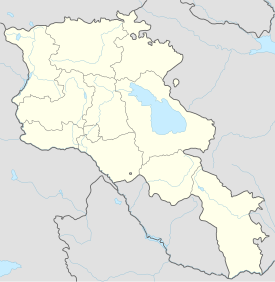Aghjots Vank
| Aghjots Vank Աղջոց վանք |
|
|---|---|

Aghjots Vank with the small chapel of 1270 (left)
|
|
| Basic information | |
| Location | Located approximately 3 miles from Goght and Garni, and .5 miles from the hamlet of Mets Gilanlar in the Khosrov State Reserve, Ararat Province, |
| Geographic coordinates | 40°06′25″N 44°48′27″E / 40.106929°N 44.807396°ECoordinates: 40°06′25″N 44°48′27″E / 40.106929°N 44.807396°E |
| Affiliation | Armenian Apostolic Church |
| Region | Caucasus |
| Status | Abandoned/ Ruins |
| Architectural description | |
| Architectural type | Armenian; Monastery |
| Founder | Grigor Lusavorich |
| Funded by | Princess Zaza, Ivane Zakarian and Prince Grigor Khaghbakian. |
| Groundbreaking | Unknown |
| Completed | Saint Stephen Church, early 13th century Saints Paul and Peter Church, 1270 Gavit, late 13th century |
Aghjots Vank (Armenian: Աղջոց վանք); also known as the Saint Stephen Monastery of Goght (Armenian: Գողթի Սուրբ Ստեփանոս վանք), is a 13th-century monastery situated along a tributary of the Azat River Valley within the Khosrov State Reserve located half a mile walk from the hamlet of Mets Gilanlar, and near the villages of Goght and Garni (approximately 3–4 miles) in the Ararat Province of Armenia. Not far from this location and also within the reserve is the fortress of Kakavaberd and the monastic complex of Havuts Tar.
The etymology of Aghjots Vank is derived from the nearby abandoned village of Aghjots.
According to local folklore, the monastery was founded by Grigor Lusavorich upon the site of the martyrdom of Stepanos (Stephen), a supposed companion to Saint Hripsime during the time of Armenia's conversion to Christianity in 301 AD. The 5th-century Armenian historian Agathangelos wrote that the young and beautiful Hripsimé who at the time was a Christian nun in Rome, was to be forcefully married to the Roman emperor Diocletian. She and the abbess Gayané among other nuns fled the tyrant emperor and left to Armenia. The pagan Armenian King Trdat received a letter from Diocletian in which he described her beauty. Trdat discovered where the nuns were hiding, and fell in love with Hripsimé and later Gayané. After her refusal of his advances, Hripsimé was tortured and martyred at the location of Saint Hripsime Church, while Gayané was tortured and martyred at a separate location where Saint Gayane Church was later built in 630. The remaining group of thirty-eight unnamed nuns were martyred at the location where the church of Shoghakat is today. During the time that Hripsimé was being tortured, Gayané told her to "be of good cheer, and stand firm" in her faith. King Trdat was to be later converted to Christianity and made it the official religion of the kingdom.
...
Wikipedia

